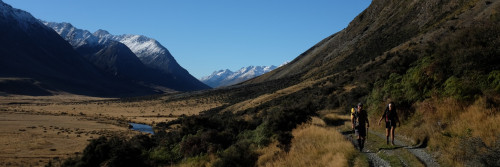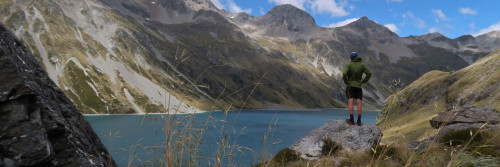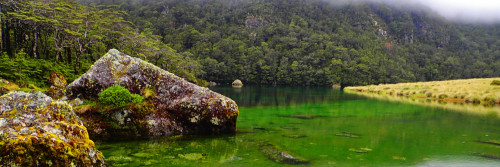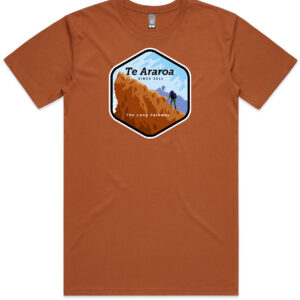News and media
Death of a long distance walker
![]()
![]()
![]()
![]()
![]()
.jpg)
Trails deliver interesting oddments. My shelf collection includes a No. 8 wire fencer’s knot, a length of rare Hodge’s Spur barbed wire, a Russian Commissar’s brass button from Chernobyl gifted to me when I was out on the Twain Track, also one black bootie from a sled dog on the Iditarod trail.
Trails deliver interesting friends. The bootie was posted to me in 1999 from Tom Stone who was then skiing across Alaska, dragging a sled. I’d met Tom a few months earlier in New Zealand. His calling card described the mission -
“A 6-year hiking trek around the world (except weekends).”
‘Except weekends’ was typical Tom. His throwaway humour and his walking distance – 32,000 kilometres by the time I met him – lent him a natural gravitas. He signed off his letters “Stay calm, wait for the sign” and what might have sounded cheesy seemed like simple hard-earned advice from Tom’s grizzled pen.
Extreme walkers walk towards something – some light out in front, or they walk to get away from something, a darkness. Tom had been a soldier in the Vermont National Guard. He had excellent outdoor skills, and was part of the Vermont First Response (Civil Emergency) Team. Then he’d copped a knee injury and was dropped from the team. That didn’t suit Tom's personality. He resigned from the military, broke trail in deep snow at the top of the Appalachian Trail in April 1992, and the knee hurt, but he just kept going, and after three months he knew he was capable of doing it. Walking around the world – that was the mission and we should put it on the side of the light. But there was also Dana Stone, Tom’s brother, 15 years older – and that was darkness. Tom walked in his brother’s path too.
Dana Stone first arrived in Vietnam in 1965, aged 26 on the deck of a freighter. He was a novice photographer who quickly became one of the war’s best photographers, working for UPI then CBS. On Dana’s visits home to Vermont, as others would recall later, the young Tom Stone listened silent and attentive to his hero brother’s stories of war.
Dana and Time Magazine’s fellow photojournalist Sean Flynn were fearless in the battlezones, and hip to the action. The two got word that America ground forces were preparing to push into Cambodia in April 1970, a major escalation of the Vietnam war. They hired two red motorcycles in Phnom Penh, rode out of the Cambodian capital towards the border, and disappeared. Dana had a big reputation and Sean was also the only son of actor Errol Flynn. Their disappearance made world headlines, but the final accounting didn’t come out until the 1990s and then remained short on detail. A North Vietnamese Army unit had stopped the two Americans at a roadblock, then turned them over to the Khmer Rouge. They lived for a year in captivity, perhaps useful as a POW swap and shifted from place to place, but were then executed, probably at a Khmer Rouge camp in Bei Met village.
Within a year of his brother’s disappearance, Tom joined the Vermont National Guard, straight from school.
There was military service, there was a footloose plan to join the French Foreign Legion, there was a favourite poem from Robert Service - The Men That Don’t Fit In - then there was the round-the-world walk that brought him to New Zealand, and I sat down with him over a coffee in Devonport, and took notes. Tom had walked across Canada, Europe, Russia, Japan, Korea, China sleeping in a bivvy bag under bridges, and he'd walked towards Dana’s deadly territories. Six years into his epic journey, Tom walked into Phnom Penh and sought advice on going into the villages that had hustled Dana through his last year of life. Cambodia was no longer at war – it was a year of democratic elections – but it wasn’t quite peaceful either. Armed Khmer Rouge units still held parts of the country, and there were military checkpoints on the roads. Tom walked for Dana into the hill country up near the Cambodian border, and a bullet whacked close to his own head. He took it as a warning, waved at the gunman without turning around and kept walking out.
He hiked Australia’s Nullabor, then come across to New Zealand.
The bone-deep cold in Siberia, wolves and bears, that Cambodian bullet . . . I asked him the journalist’s question: what was the closest he’d come to death on his tramp?
New Zealand. In the South Island he’d hiked the Copland Pass Track, crossing the ankle deep Shiels Creek on the way up, sitting in the hot water pool at Welcome Flat while fantails picked off the mosquitoes humming around his head. The weather turned to squalls. He reached Shiels Creek on the return journey and it was waist-deep and rolling boulders. Tom had crossed a lot of rivers on his trek. He was a confident outdoorsman. He cut a staff and he was 10 metres across the creek with 5 metres to go.
“A huge rock the size of a colour TV picked up and headed south. I had a foot braced on that, and I went too. It was a jet boat ride, but it was like I was strapped to the bottom of the boat.”
The frothing creek had no buoyancy and Tom couldn’t get his head up. He managed one breath of air as he tumbled 150 metres. He was nearly gone and one eye stared up through the foam and fixed on an overhead branch. One arm swung up and one last-chance hand clamped onto the branch. Tom had just saved himself from a final tumble over a waterfall and into the swollen Copland River. He lost his pack and jacket, one shin was stripped to the bone, one knee made popping sounds every time he moved. Bleeding, cold, and semi-naked he made his way back to the track and was limping slowly out when he met a tramper coming the other way. That tramper wrapped him, heated a hot water bottle for him, and called in Search and Rescue. He was choppered out to Greymouth Hospital, taken into theatre there and repaired.
A local woman, Marion Gilbertson, took him home to recuperate for two weeks and when he was strong enough to walk he went back up to see if he could retrieve his gear. He found only a battered ground sheet. The loss of his contact book, with its addresses from around the world, was the worst thing.
After walking the South Island, he’d come up through the North Island, and arrived at the Devonport Information Centre seeking the best off-road route to Cape Reinga. My wife Miriam was working in the centre, and I’d just finished walking that same route. She told him: “I have just the man you want to see.”![]()
.jpg)
The animals loved him. The cat sat on his lap, the dog at his feet. Here in this lounge, the impossible global walker - what can you say? He brought with him the breath of possibility. He was a relaxed guest, a teller of tales from beyond the horizon and for a few days he became simply and easily a part of the family. Then he went north, staying sufficiently within range for the first two days that we picked him up and brought him home for a hot meal before returning him next day to the start point. He walked to the Cape in 10 days, a distance of around 450 km.
Then he was gone – to Alaska where he walked and skied the Iditarod Trail pulling a sled, and on to Canada, where, coming down from the north, he crossed the Rockies twice. The last letter I had from him was dated 18th of October 1999. He was then at Jasper National Park, within 10,000 km of completing his round-the-world walk. The letter was full of wildlife detail – the sound of the elk's bugle call, and the wolves at night, the geese returning home after winter, the risk of falling asleep walking on the Canadian prairies. He signed off the letter “Tom (moving target) Stone” and with a PS – “Like the good paratrooper deals with his descent . . . Remember feet and knees and always assess your rate of drift, especially on those long straight sections of life.”
That was it, except that we always wondered what happened to Tom. He wasn’t the type to fail, and we knew he'd have finished his walk. We knew also he’d be on another adventure somewhere. Quite what triggered the Google search just the other day I don’t know, perhaps it’s just one of the things you do now on a wet afternoon, sooner or later, to trace your interesting friends.
The single site dedicated to Tom Stone was easy to miss, but dozens of people had written their recollections there and donated to a school in his memory. He’d been dead over two years. The jolt that gave us was even more disturbing for not having known.
When Tom completed his walk, back across Canada to Vermont, he’d gone back into the military. One of the army buddies on the website recalled being beside Tom as they watched the Twin Towers attack of 9/11 on a small TV screen ". . . we knew our lives in the National Guard had changed.” Tom went on to serve three tours in Afghanistan. He’d trained as a medic and ran a clinic in the south that treated hundreds. He was, said the posts, enormously popular with the local children.

On his last tour as part of an Embedded Tactical Training team at a base for coalition forces at Lashkagar in Southern Afghanistan he was also instructing Afghan National Army troops.
On the night of March 29 2006, Taleban fighters attacked the newly established base with automatic weapons and mortar fire.
The Canadians had a special operations team in one compound. As the fire fight developed, one Canadian soldier was killed there, and three Canadians were wounded. In the American sector another soldier was hit, and the call went out for a medic. Tom Stone ran to attend the wounded American and despite body armour was shot dead.
The Army news release stated simply that the coalition forces at the Lashkagar Base had lost two soldiers during the Taleban attack. It named one Canadian and one American trooper with a further five wounded.
Canadian journalists – sensitive to every Canadian death after an early friendly fire incident where an American fighter pilot killed four Canadians in Afghanistan – wanted more detail than was provided by the National Guard summary, but remained frustrated.
It took Associated Press another 15 months, to July 4 2007, to ferret information under the Freedom of Information Act that both the Canadian soldier, Pvt Robert Costall (22) and Vermont National Guard Sgt Tom Stone (52) were shot from behind that night by an American 240B machine gunner. In the confusion of the night attack the gunner had fired firstly at the Canadian position, then into the American sector.



